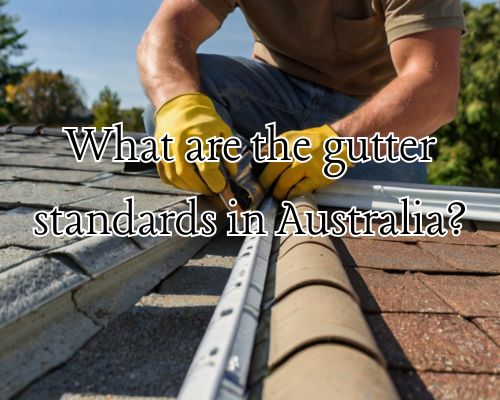
What Are the Gutter Standards in Australia? A Complete Guide for Melbourne Homeowners
What Are the Gutter Standards in Australia? A Complete Guide for Melbourne Homeowners
When it comes to building or renovating a property in Australia, ensuring compliance with national and local standards is critical. One such vital aspect is gutters. Properly installed gutters protect your home from water damage and ensure proper drainage, which is particularly important in Melbourne’s climate. But what exactly are the gutter standards in Australia, and how do they apply to homes in Melbourne? Let’s dive in.

Australian Gutter Standards: An Overview
The installation, maintenance, and design of gutters in Australia are governed by several building codes and standards. The primary regulations include:
- The National Construction Code (NCC):
- The NCC provides overarching guidance on gutter installation, ensuring they meet structural and safety standards.
- Australian Standard AS/NZS 3500.3 (Plumbing and Drainage):
- This standard outlines the requirements for stormwater drainage, including gutter sizing, overflow provisions, and downpipe placements.
- Australian Standard AS/NZS 2179.1 (Rainwater Goods):
- This focuses on materials used for gutters, including corrosion resistance and durability.
Key Requirements of Australian Gutter Standards
1. Gutter Sizing
Proper gutter sizing is crucial to prevent overflowing during heavy rains. Standards dictate that gutters must be sized based on the rainfall intensity of the location. Melbourne’s average annual rainfall is approximately 650mm, and the standards ensure gutters can handle peak storm conditions.
2. Slope and Fall
Gutters must have a minimum slope of 1:500 to ensure water flows effectively toward downpipes. Without the right gradient, water pooling can lead to corrosion, blockages, and long-term damage.
3. Overflow Measures
To handle heavy rain events, gutters must include overflow provisions, such as slots or weirs. This prevents water from backing up into the roof cavity, which can lead to structural damage.
4. Downpipe Placement
Downpipes should be strategically placed to ensure efficient water drainage. The standard requires at least one downpipe for every 12 meters of gutter length.
5. Material Durability
Gutters in Australia must be made of materials resistant to corrosion and weathering. Common materials include:
- Colorbond steel
- Zincalume
- Aluminum
- PVC
These materials are tested to withstand Australia’s varied climates, including Melbourne’s mix of wet winters and hot, dry summers.
Melbourne-Specific Considerations for Gutter Standards
1. Climate Impact
Melbourne’s unpredictable weather requires gutters that can adapt to fluctuating conditions. The city often experiences four seasons in a day, meaning gutters must handle sudden downpours effectively.
2. Bushfire Compliance in Surrounding Areas
If your property is located in Melbourne’s outer suburbs, such as the Dandenong Ranges or Yarra Valley, you may need gutters that meet bushfire safety standards. The BAL (Bushfire Attack Level) rating determines specific gutter requirements, such as the need for ember guards.
3. Leaf and Debris Accumulation
Melbourne properties surrounded by trees, especially in suburbs like Kew or Camberwell, require gutter guards to prevent blockages. Clogged gutters not only cause water overflow but also increase the risk of pest infestations.
Benefits of Complying with Gutter Standards
1. Preventing Water Damage
Compliant gutters protect your home from water damage, particularly during Melbourne’s storm season.
2. Improved Longevity
Using high-quality materials and proper installation techniques ensures that gutters last longer, saving you money on repairs.
3. Increased Property Value
Potential buyers often look for well-maintained homes with compliant infrastructure. Investing in proper gutters can enhance your property’s value.
Tips for Choosing the Right Gutter System in Melbourne
1. Consult a Local Professional
Work with a licensed plumber or roofing specialist familiar with Melbourne’s building codes. Local experts like in Gutter Cleaning Melbourne can help you select the best materials and designs for your property.
2. Opt for Gutter Guards
Protect your gutters from debris by installing guards. They’re particularly beneficial for homes in leafy Melbourne suburbs like Toorak and Brighton.
3. Regular Maintenance
To keep gutters in top shape, clean them at least twice a year. Schedule inspections before Melbourne’s rainy season to ensure they’re functioning correctly.
Common Mistakes to Avoid
1. DIY Installation Without Knowledge of Standards
While DIY projects can save money, gutter installation requires precise knowledge of Australian standards. Mistakes can lead to non-compliance and costly repairs.
2. Ignoring Overflow Provisions
Failing to include overflow measures can result in water damage during heavy rainfall, which is a frequent occurrence in Melbourne’s winter months.
3. Using Substandard Materials
Always choose gutters that meet Australian standards for durability and corrosion resistance. Substandard materials will deteriorate quickly in Melbourne’s variable weather.
Final Thoughts
Understanding and complying with gutter standards in Australia is essential for Melbourne homeowners. By following the guidelines set out in the NCC and relevant Australian standards, you can ensure your home is well-protected from water damage, bushfire risks, and long-term structural issues. If you’re planning to install or upgrade your gutters, consult a local professional like in Gutter Cleaning Melbourne to ensure compliance and peace of mind.
For Melbourne residents, proper gutter systems are not just a regulatory requirement but also a practical necessity given the city’s climate and unique environmental factors. By investing in high-quality gutters and maintaining them regularly, you’ll safeguard your property while boosting its value and curb appeal.